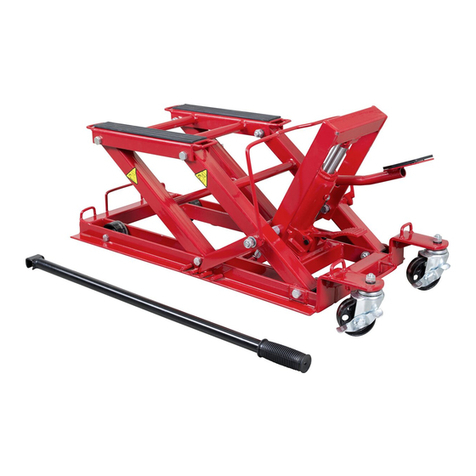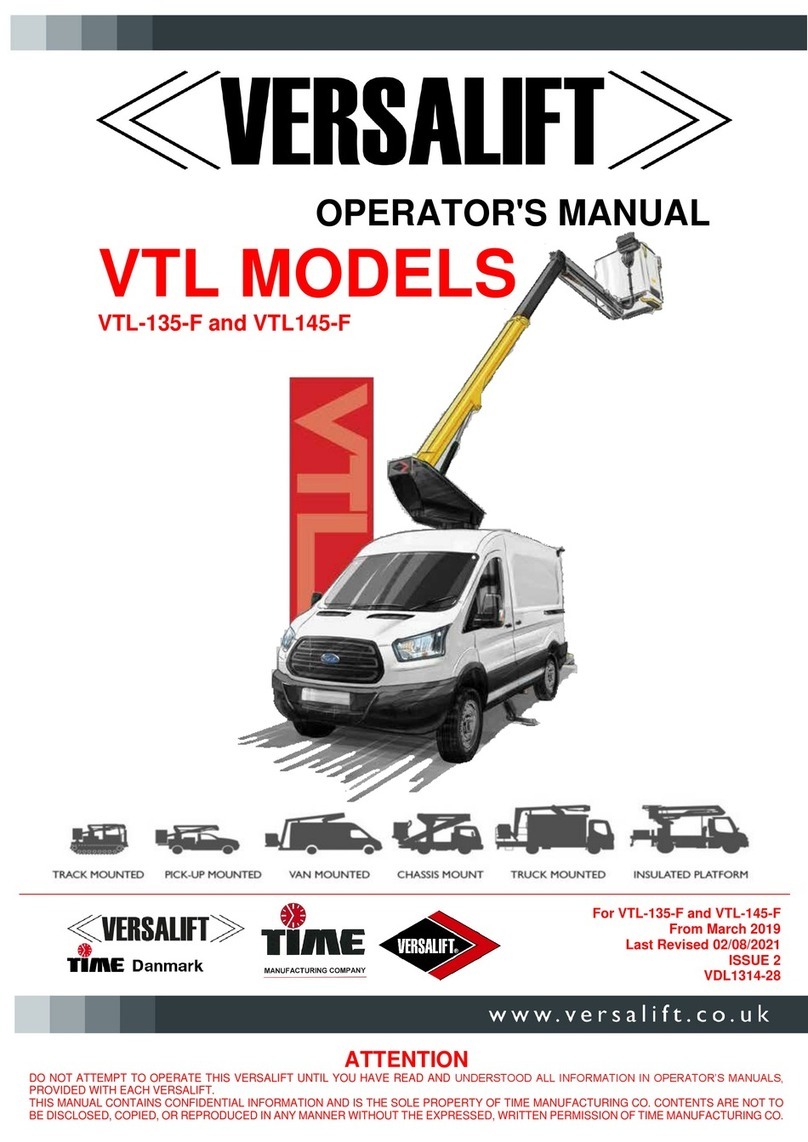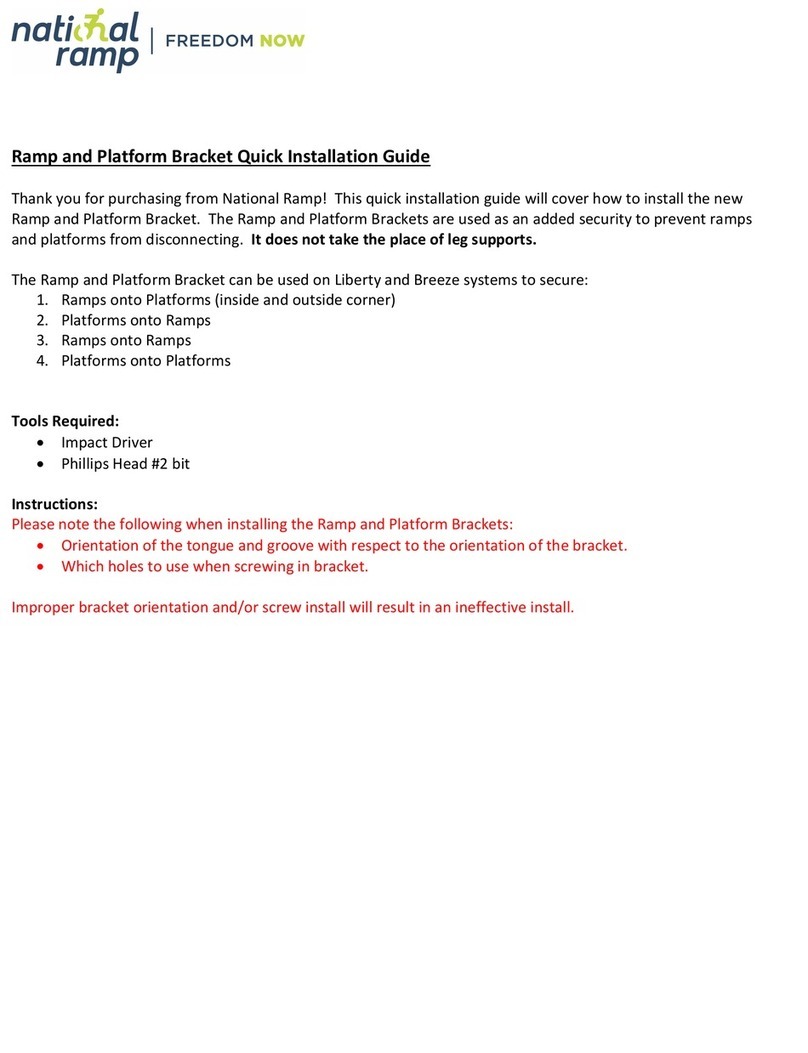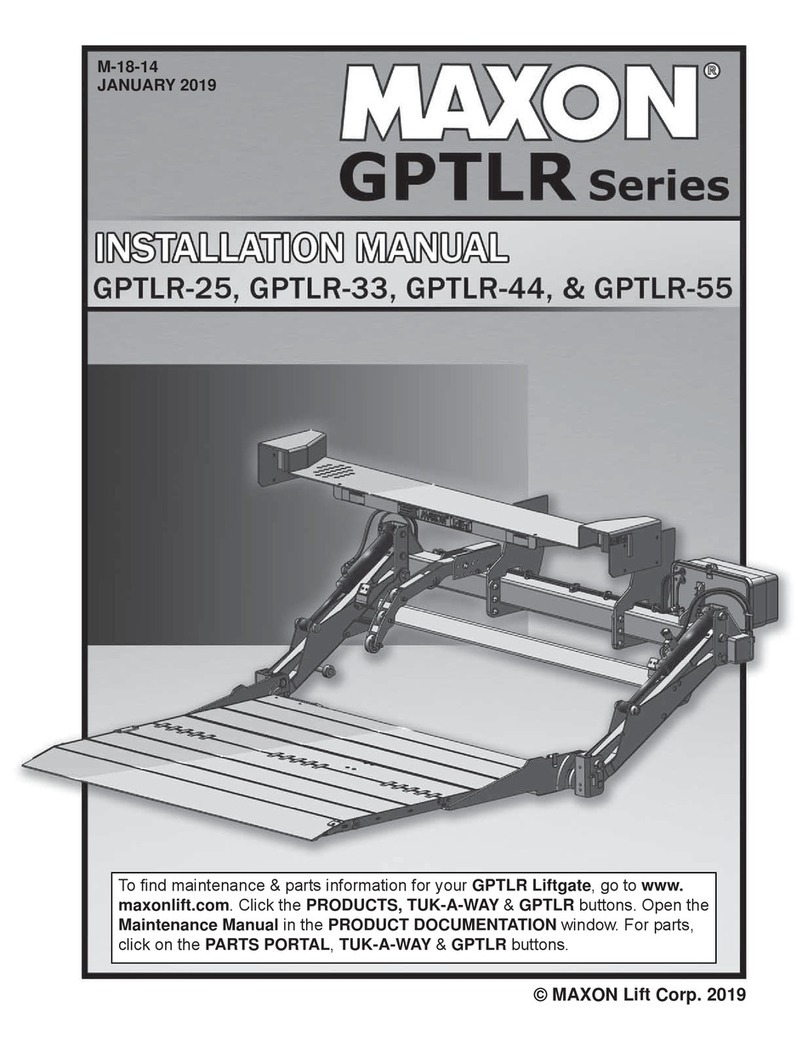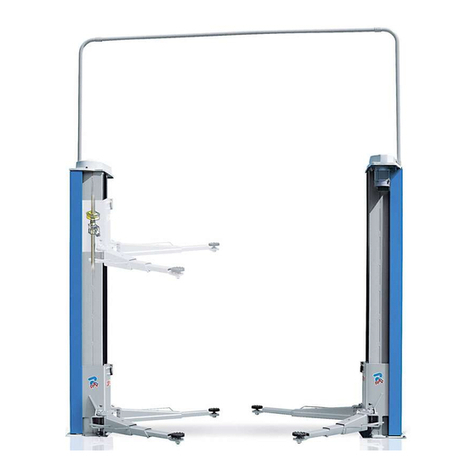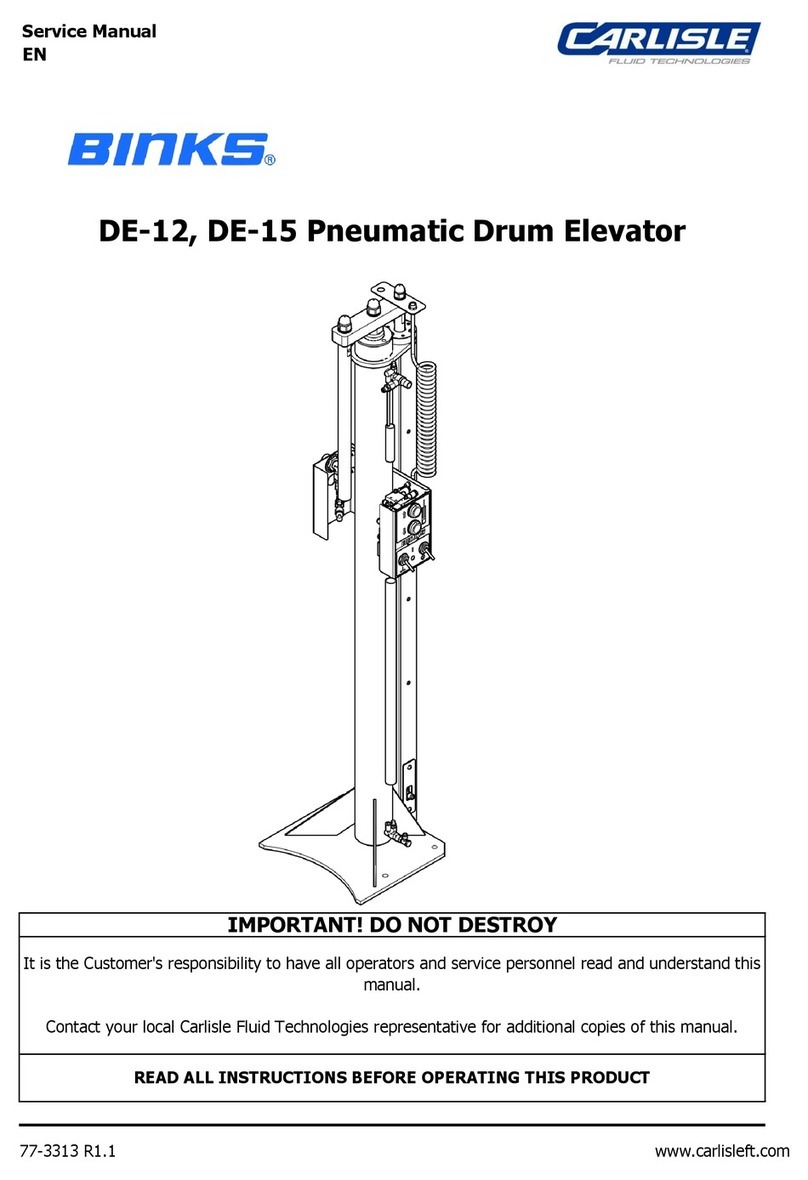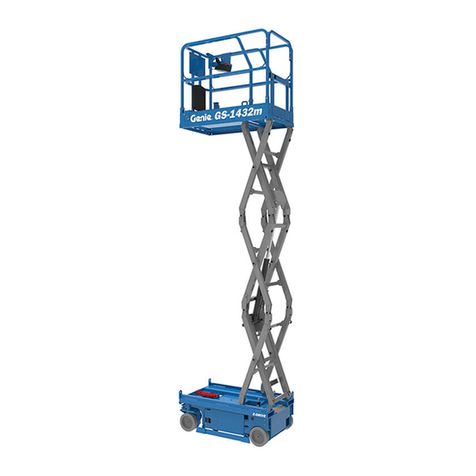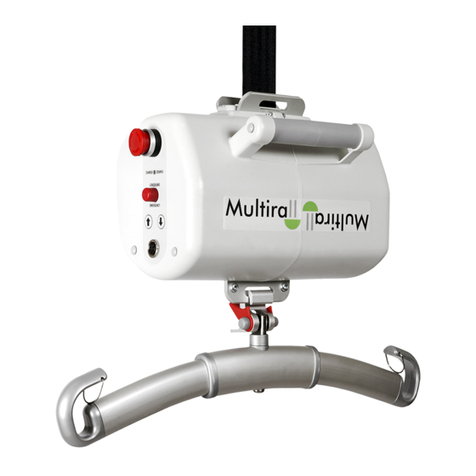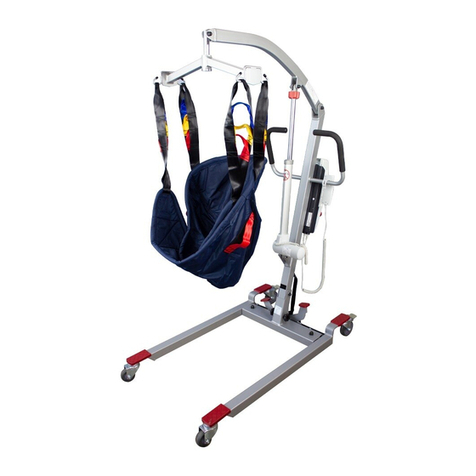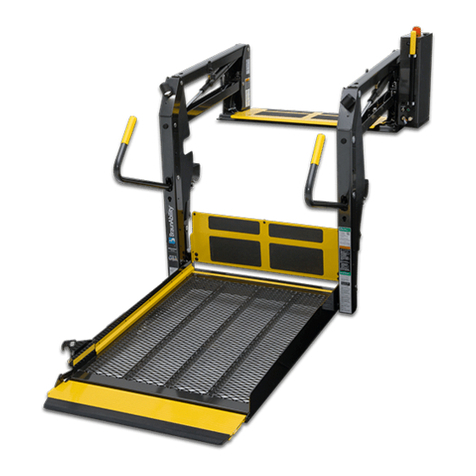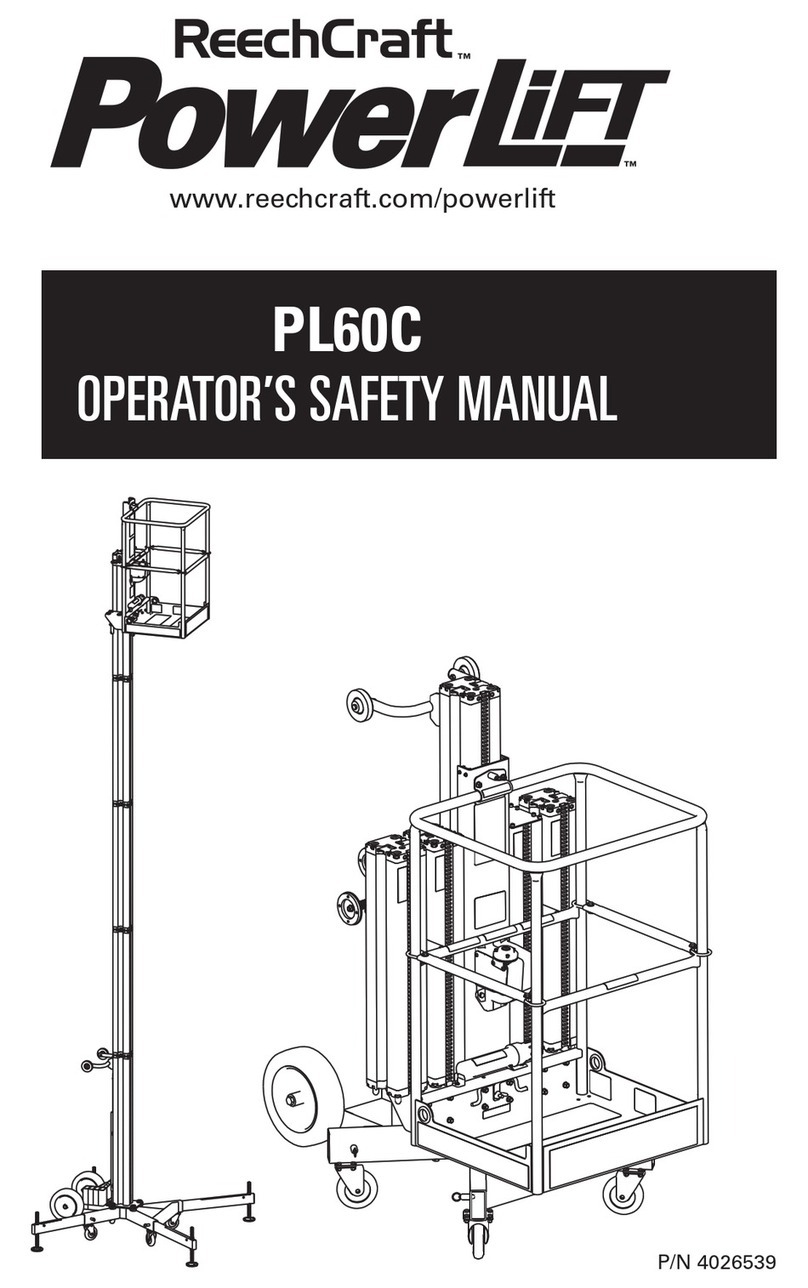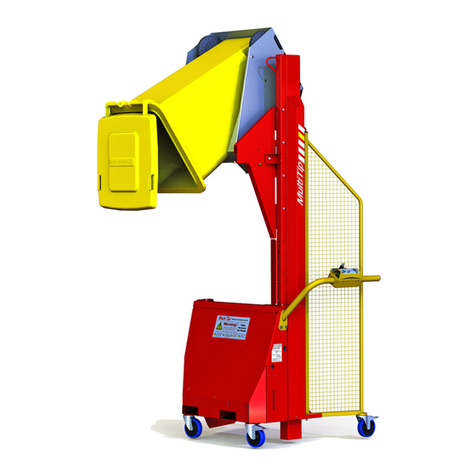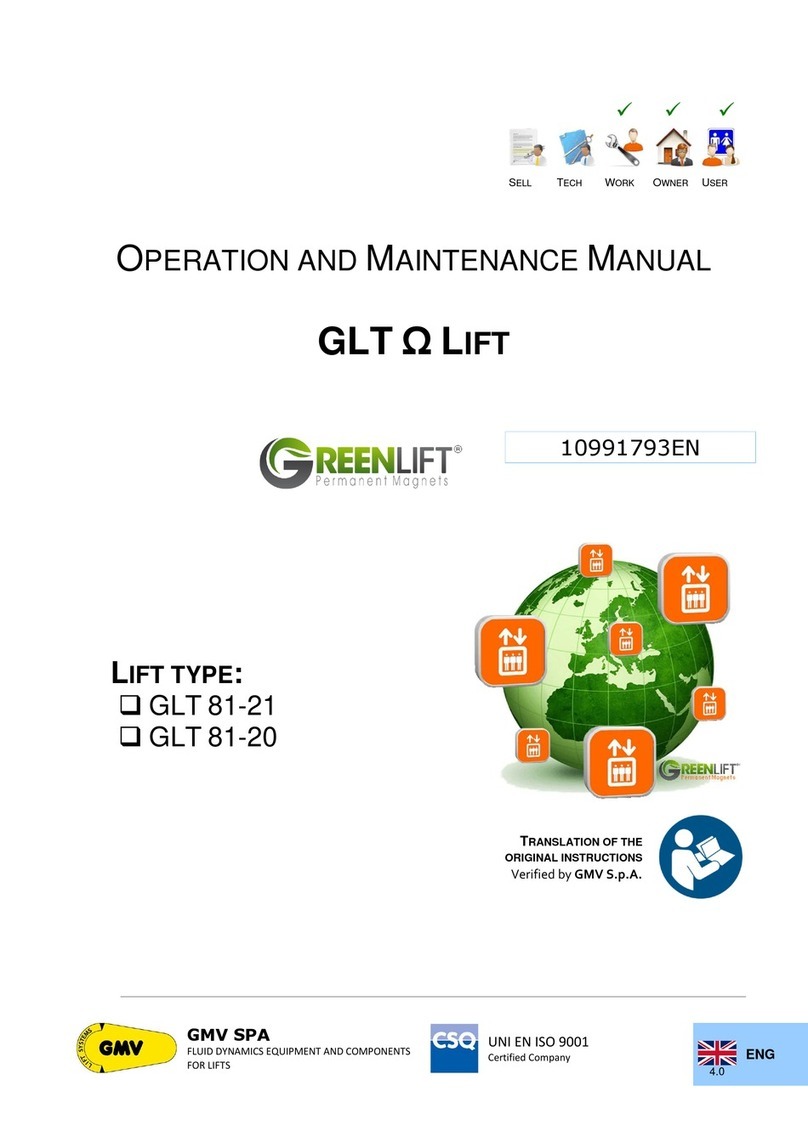Big Lift Big Joe M22 User manual

OPERATOR’S MANUAL
Big Lift LLC
www.bigjoeforklifts.com Manual Part No. 901638
08/16/2018
MANUAL PROPELLED
SEMI-ELECTRIC
STRADDLE
LIFT TRUCK


1
FOREWORD
As a lift truck operator, you are responsi-
ble for a machine that is useful, powerful,
and can be hazardous if not operated as
described. Your Big Joe truck may weigh
more than some cars, depending on the
model. Observing and practicing the
safety warnings in this manual cannot be
overemphasized. Just knowing the warn-
ings, however, is no substitute for common
sense. Using your common sense will, in
almost all cases, prevent accidents. Think
of the truck as your own. In this way you
will learn its capabilities and limitations.
This manual is intended to remain with the
truck at all times as a handy reference
guide to operation. Detailed maintenance
procedures are found in the parts and ser-
vice manual for the specific truck model,
and are to be performed only by a quali-
fied technician. For further information on
obtaining a complete parts and service
manual, see page 21 of this manual. The
operator who knows his truck will learn to
spot problems as they develop. This is
accomplished by performing the Daily
Checks and reporting any problems to the
designated authority.
TABLE OF CONTENTS
FOREWORD..........................................................................................................1
SAFETY SYMBOLS..............................................................................................2
GENERAL DESCRIPTION....................................................................................2
LOAD CAPACITY..................................................................................................4
BEFORE OPERATION..........................................................................................5
INSTRUMENTS AND CONTROLS.......................................................................7
OPERATION..........................................................................................................8
TRANSPORT............................................................................................8
OPERATING THE LIFT ............................................................................9
LOADING AND UNLOADING..................................................................9
PARKING..................................................................................................9
BATTERY CHARGING ...........................................................................10
MOVING A DISABLED TRUCK.............................................................10
.............................................................................................................................10

2
SAFETY SYMBOLS
WARNING and CAUTION are both signal words intended to alert the viewer to the exis-
tence and relative degree of a hazard. They are both preceded by a safety alert symbol
consisting of an exclamation mark enclosed by a triangle.
A Warning indicates a hazard which could result in injury or death if proper precautions are
not taken.
A Caution indicates a reminder of routine safety practices.
A prohibition slash (circle with diagonal slash through it) indicates a procedure or action
that should not be performed under any circumstances, as both personal injury and/or dam-
age to equipment will result.
GENERAL DESCRIPTION
Big Joe LLC M22 utilize the straddle leg
configuration, which normally straddles
the load.
The mast handles are used to help control
the lift truck. The control handle is used to
propel and steer the lift truck. Lift and
Lower are controlled by a lever located
near the operator.
The model number will be found on the
name plate along with the serial number,
lifting capacity and load center.
If the name plate or warning decal are lost
or damaged they should be replaced
immediately. Have your supervisor or the
designated authority contact Big Joe
Authorized Dealer for replacement
.
Name Plate
N

3
This truck is equipped with a battery. Read and heed the following warning plus any other
warnings located near or on the battery. An example is shown here:
WARNING:

4
LOAD CAPACITY
The further the load center is from the
backrest, the lower the load capacity. The
load center must also be no higher than
that specified above the lifting surface
(Top side of forks). For example, a load
capacity of 2200 pounds with a load cen-
ter of 24 inches means that the truck can
be used to lift 2200 pounds only when the
load’s center of gravity is no more
than 24 inches from the face of the forks
or 24 inches above the top side of the
forks. Note that a truck under-going speed
changes is less stable than a standing
truck. If you are not sure that the truck can
lift a certain load, consult your supervisor
or the designated authority.
An overload can cause machine damage
and stability loss or tipping of the lift truck.
Load Center
R3814

5
BEFORE OPERATION
The table on page 6 covers important
inspection points on the truck which
should be checked prior to operation.
Depending on use, some trucks may
require additional checks.
The illustration below shows a sample for-
mat for an Operator Checklist, which can
be modified as necessary to fit your opera-
tion.
Periodicmaintenanceofthistruckby
a QUALIFIED SERVICE TECHNI-
CIAN is required.
A QUALIFIED SERVICE TECHNI-
CIANshouldcheckthetruckmonthly
for proper lubrication, proper fluid
levels, brake maintenance, motor
maintenance and other areas spec-
ified in the parts and service manual
maintenance section.
Ifthetruckisfoundtobeunsafeand
inneedofrepair,orcontributestoan
unsafe condi-tion, report it immedi-
atelytothe designated authority. Do
not operate it until it has been
restored to a safe operating condi-
tion. Do not make any unauthorized
repairs or adjust-ments. All service
must be performed by a qualified
maintenance technician.
If the truck has not been used for a long
time (more than a month), regular battery
maintenance should be performed.
Sample of Operator Check List
WARNING:
WARNING:
WARNING:

6
Operator Checks
ITEM PROCEDURE
Key Switch Check that key switch disconnects & restores
truck power when turned off and on.
Battery capacity Before operation, turn on key switch and
check that the electric capacity is enough. If
low, recharge the battery.
Hydraulic system Check for signs of fluid leakage.
Forks Check for cracks and damage and that they
are properly secured.
Chains, cables and hoses Check that they are in place, properly secured
and not damaged.
Guards Check that safety guards are in place, prop-
erly secured and not damaged.
Safety signs Check that warning labels, nameplate, etc.,
are in good condition and legible.
Wheels Check drive wheel for cracks or damage.
Move truck to check load wheels and casters
for freedom of rotation.
Lift and Lower Check operation of lift and lower to their maxi-
mum positions.
Floor Lock Check that floor lock holds the truck station-
ary.

7
INSTRUMENTS AND CONTROLS
The instrument panel contains the key
switch,lift/lowercontrollever,voltmeterand
charging indicators.
The foot actuated floor lock is used to hold
thetruckstationary.Theoperatormasthan-
dles located on each side of the mast are
used to help control the truck.
Thespringloadedsteeringhandleisusedto
propel and steer the lift truck. It is linked to
the left caster to provide steer tracking.
Control Handle
Battery Indicator
R6733

8
OPERATION
TRANSPORT
Moving and Stopping
NOTE: Thetruckshouldonlybeoperated
on a level surface.
1. Turn on the key switch and check that
the electric capacity is enough. If low,
recharge the battery
2. Checkthattheloadisinthedownposi-
tion before traveling.
3. Release the floor lock.
4. Apply pressure to the steering handle
andmasthandlestomovethetruckfor-
ward. Pull evenly on the steering han-
dle to move the truck backward.
5. To stop the lift truck, hand restraint
against the steering handle and mast
handles is usually adequate.
6. After the lift truck has stopped, always
engage the floor lock before lifting or
lowering and when parking.
7. Turn off the key switch to prevent bat-
tery drain and to prolong the service
life.
M22 Lift Truck
R6733

9
Turning
1. Release the floor lock.
NOTE: Turning and maneuvering the lift
truck is made easier if the truck is
in motion.
2. Begin rolling the truck and simultane-
ously apply side pressure to the steer-
ing handle to cause the caster wheels
to swivel.
OPERATING THE LIFT
WARNING: Check the space above
the load on the forks to
ensure that the load will
notstrikeanyobstruction
while being raised.
1. Turn the key switch ON.
2. To raise the forks, pull the lift con-trol
back and hold until the forks reach the
desiredheight.Theforkswillraiseata
fixed speed. Return the lift control to
the neutral position.
3. To lower the forks, push the lift control
forward and hold until the forks reach
the desired level. The lowering speed
can be controlled by the lever. Return
the lift control to the neutral position.
LOADING AND UNLOADING
1. Move the truck to the location where
the load is to be picked up.
2. Adjust the forks to the maximum prac-
tical width to support the load.
3. Raisetheforkstothedesiredheightfor
entry under the load.
4. Move the lift truck into position so that
the forks are centered under the load.
5. Move the lift truck forward to place the
loadasfarbackaspos-sibletowardthe
lift carriage. Raise the forks to lift the
load.
CAUTION: To avoid spilling the load,
moveslowlyand useextra
caution when turning.
6. Move the lift truck backward from the
loading position.
7. Whentheloadisclearofitsrack,lower
the load, leaving enough floor clear-
ance to maneuver the truck.
8. Push or pull the truck carefully to the
area where the load is to be placed.
9. Alignthelifttruckwithits new position.
10. Raise the forks to the desired height
andslowlymovethe lifttruckinto posi-
tion for off-loading.
CAUTION:Theloadmustrestsquarely
on its rack when it is low-
ered into position.
11. When the load is in position, lower the
forksuntilthepalletrestsonitsrackand
the forks are free.
12. Slowly move the lift truck back-ward,
checkingthattheforksdonotcatchon
the pallet or rack.
13. Lower the forks when they are clear.
14. Proceed to move the next load.
PARKING
When finished with moving loads, lower
the forks and move the lift truck to its
maintenance or storage area. Engage the
floor lock. Turn off the key switch. Charge
the battery if required.

10
BATTERY CHARGING
Refer to DOC 245 for battery safety and
maintenance.
Turn on the key switch when charging the
battery. Charge for 3 to 5 hours (but not
more than 24 hours).
NOTE: Battery charging instructions are
contained in the service manual.
MOVING A DISABLED TRUCK
Do not attempt to move a disabled truck;
notify your supervisor or proper authority.

11
The following operating instructions should be followed at all times when using truck.
Do not operate this truck
unless you have been
trained and authorized to do
so, and have read and un-
derstand all warnings and
instructions contained in
this operator’s manual.
R6733
Do not operate this truck un-
til you have checked its con-
dition. Give special attention
to tires, horn, lights, battery,
controller, lift systems (in-
cludingforksorattachments,
chains, and cables), floor
lock, steering mechanism,
guards and safety devices. If
you have any questions, no-
tifyyoursupervisor or proper
authority.
R6733

12
R7184
Never place any part of the
body into the mast structure.
R7185
Do not carry passengers.

13
R7186
Keep feet clear of truck and
always wear foot protection.
R7187
Observe applicable traffic
regulations. Yield right-of-
way to pedestrians. Slow
down and at cross aisles
and wherever vision is ob-
structed.

14
R7188
Start, stop, travel, steer
and brake smoothly. Slow
down for turns and on un-
even or slippery surfaces
that could cause truck to
slideoroverturn.Usespe-
cial care when traveling
without load as the risk of
overturn may be greater.
R7189
Travel with lifting mecha-
nism as low as possible.
Alwayslookindirectionof
travel. Keep a clear view,
and when load interferes
with visibility, travel with
load or lifting mechanism
trailing.

15
R7190
Do NOT operate on Ramps!
R7191
Donotoverloadtruck.Checknameplateforloadweight
capacity and load center information.

16
R7192
When using forks,
space forks as far apart
as load will permit. Be-
fore lifting, be sure load
is centered, forks are
completely under load,
andloadisasfarbackas
possible against load
backrest.
R7193
Do not handle unstable or
loosely stacked loads. Use
special care when handling
long, high or wide loads to
avoid losing the load, strik-
ing bystanders or tipping
the truck.

17
R7194
Do not handle loads which
are higher than the load
backrest or load backrest
extensionunlessloadisse-
cured so that no part of it
could fall backward.
R7195
Elevate forks or other lift-
ingmechanismonlytopick
up or stack a load. Watch
out for obstructions, espe-
cially overhead.

18
R7196
Donotliftpersonnelwith
this truck. It is not de-
signed for this function
and someone could get
seriously injured if they
fell off. Use the correct
equipment for this task.
R7197
Donotallowanyonetostand
orpassunderaloadorlifting
mechanism.
Table of contents
Other Big Lift Lifting System manuals

